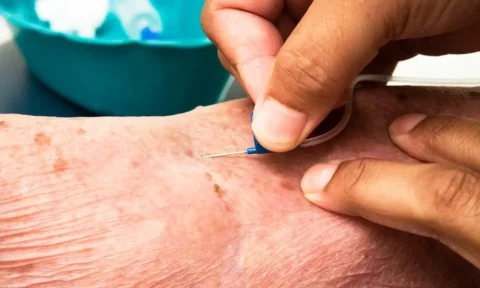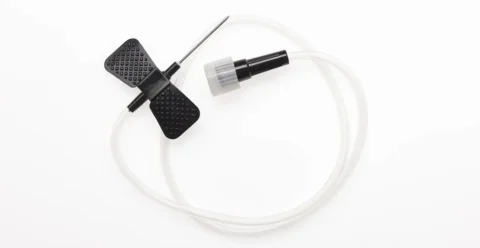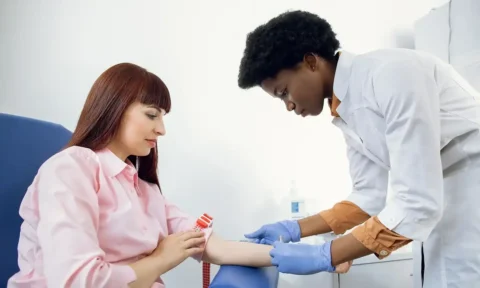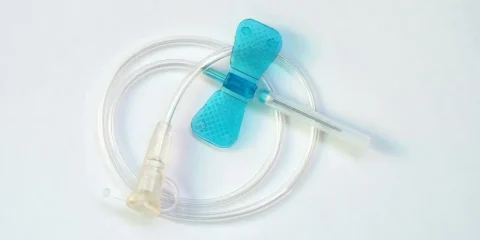Understanding the Compatibility of Butterfly Needles with IV Infusions
The medical world is full of tools and techniques that cater to the needs of patients and healthcare professionals. When it comes to administering medication or drawing blood, there’s often a debate on which method is most suitable. One such question is whether you can use a butterfly needle for an intravenous (IV) infusion.
In this article, we’ll explore the uses of butterfly needles, their compatibility with IV infusions, and other related topics.
What is a Butterfly Needle?
A butterfly needle, also known as a winged infusion set, is a small, thin needle used primarily for drawing blood samples or administering medications subcutaneously.
Components of a Butterfly Needle
A butterfly needle consists of three main parts:
- A short stainless steel needle
- Flexible “wings” on either side of the needle, which provide a grip for easier insertion and control
- A flexible tubing that connects the needle to a syringe or vacuum tube
What is an IV (Intravenous) Infusion?
IV infusion is a medical technique that involves delivering fluids, medications, or nutrients directly into a patient’s bloodstream through a vein.
Types of IV Catheters used in IV Infusions
There are several types of IV catheters, including:
- Peripheral IV catheter is a short, thin tube inserted into a peripheral vein, usually in the arm or hand
- Central venous catheter is a long, flexible tube placed in a large central vein, often in the neck, chest, or groin
- Peripherally inserted central catheter (PICC) is a long, thin catheter inserted through a peripheral vein and advanced into a central vein
Can You Use a Butterfly Needle for an IV?
In some cases, a butterfly needle can be used for an IV infusion, particularly when other methods are not feasible due to the patient’s condition or vein accessibility.
Pros and Cons of Using a Butterfly Needle for IV Infusion
Intravenous (IV) therapy often relies on traditional IV catheters, but there are alternative tools available, such as butterfly needles. To better understand whether butterfly needles can be used for IV infusions, it’s essential to examine the advantages and disadvantages of this particular tool.
In the following table, we outline the pros and cons of using butterfly needles for IV infusions, highlighting key factors to consider when choosing the right method for a specific patient or situation.
| Pros | Less painful than a traditional IV catheter |
| Easier to access small, fragile veins | |
| Lower risk of vein damage | |
| Cons | Higher risk of needle dislodgement |
| Not suitable for long-term use | |
| Limited flow rates compared to IV catheters |
How to Use a Butterfly Needle for IV Infusion
Steps to Start an IV with a Butterfly Needle
- Prepare the necessary equipment, including gloves, alcohol swabs, tourniquet, butterfly needle, tape or transparent dressing, and IV fluid or medication.
- Wash your hands thoroughly and don gloves to maintain a sterile environment.
- Identify a suitable vein for insertion, ideally in the patient’s forearm or hand. Apply the tourniquet to help make the vein more visible.
- Clean the skin around the insertion site using an alcohol swab, allowing it to dry completely.
- Hold the butterfly needle by its wings, positioning it at a 10-30 degree angle to the skin, with the bevel facing up.
- Gently insert the needle into the vein, watching for a “flash” of blood in the tubing, which indicates successful entry into the vein.
- Slowly lower the angle of the needle and advance it slightly further into the vein.
- Remove the tourniquet and secure the butterfly needle in place with tape or a transparent dressing.
- Attach the IV fluid or medication to the tubing and begin the infusion, monitoring for any signs of discomfort, infiltration, or phlebitis.
Butterfly Needle vs IV Catheter
While butterfly needles can be used for IV infusions in certain situations, there are some key differences when compared to traditional IV catheters:
| Aspect | Butterfly Needles | IV Catheters |
| Risk of Dislodgement | Higher due to shorter length and lack of stabilization features | More stable access for long-term infusions |
| Suitability for Long-term vs Short-term Use | Better suited for short-term use | Provides stable access for long-term infusions |
| Flow Rates | Lower, less suitable for rapid fluid replacement or high-volume medications | Better suited for rapid fluid replacement and delivery of high-volume medications |
In cases where you need to proceed with Butterfly Needles for your IV infusion, here are some tips for a safe and more effective procedure:
- Ensure the needle is secured properly to minimize the risk of dislodgement.
- Monitor the infusion site regularly for signs of infiltration, phlebitis, or infection.
- Choose the appropriate needle gauge based on the patient’s vein size and the infusion requirements.
Choosing the Right Butterfly Needle Gauge for IV Infusion
Butterfly needles come in various gauges, with smaller numbers indicating larger diameters. Common gauges for IV infusion include:
| Gauge | Color | Description |
| 21-gauge | Green | Suitable for most adult patients and general IV infusions |
| 23-gauge | Blue | Recommended for pediatric patients or those with small, fragile veins |
| 25-gauge | Orange | Ideal for very small or difficult-to-access veins, not for rapid fluid administration |
Risks and Complications of Using Butterfly Needles for IV
Some potential risks and complications associated with using butterfly needles for IV infusions include:
- Infiltration: Leakage of fluids or medications into surrounding tissue
- Phlebitis: Inflammation of the vein
- Infection: Bacterial contamination at the insertion site
- Hematoma: A collection of blood outside the vein due to improper needle insertion
Note: In order to avoid or minimize these risks, talk to a healthcare professional.
Takeaway
While butterfly needles are primarily used for drawing blood and administering subcutaneous medications, they can also be used for IV infusions in certain situations. However, it is important to weigh the pros and cons of using a butterfly needle for this purpose and consider when necessary. With proper technique and monitoring, butterfly needles can provide a viable option for IV infusions in select cases.
Ensure the Success of Your IV Therapy with Top-Quality Butterfly Needles
When it comes to IV therapy, the quality of the equipment you use can greatly impact both the safety and effectiveness of the procedure. Don’t compromise when it comes to your health or that of your patients. Choose Face Med Shop for all your butterfly needle needs and experience the benefits of high-quality, reliable products.
By investing in top-notch butterfly needles, you’ll have the confidence and assurance that your IV therapy will be both safe and successful. Visit Face Med Shop today and discover the difference that superior supplies can make in your medical practice.






